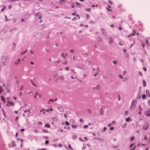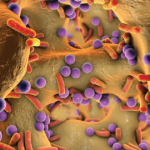Introduction & Objectives
Cryoglobulins are immunoglobulins that precipitate in vitro at cold temperatures and dissolve at 37°C. Their precipitation in vivo can result in vasculitis of small and medium vessels. They were first described in 1933 by Wintrobe and Buell with regard to a patient with myeloma associated with unilateral retinal vein thrombosis and Raynaud’s phenomenon. In 1967, Meltzer et al. first described a series of 29 cases with cryoglobulins, and in 1974, Brouet et al. proposed a cryoglobulin classification, which is widely used for its correlation with clinical presentation. Type I cryoglobulins are composed of monoclonal Ig (most frequently IgM and IgG), type II are composed of both monoclonal and polyclonal Ig, and type III are composed of polyclonal Ig. Type II and III cryoglobulins are called mixed cryoglobulins, with monoclonal or polyclonal IgM associated with IgM rheumatoid factor (IgM-RF) activity.
The characteristics of cryoglobulins reported in the literature based on type, distribution and prevalence of underlying pathology vary between studies, due to population selection bias and different cryoglobulin detection and characterization methodologies. Since the discovery in 1992 of the hepatitis C virus (HCV) and its relation to cryoglobulins, numerous epidemiologic studies have been conducted on mixed cryoglobulins. Type I cryoglobulins have been investigated to a lesser degree due to their lower frequency and clinical association with malignant disorders.
The purpose of this study was to use up-to-date techniques to perform an exhaustive immunologic description of cryoglobulins with regard to characterization and quantification. Of the 13,439 serum samples collected for cryoglobulin detection over six years, 1,675 were found to be positive and were further characterized.
Methods
A cohort of 13,439 patients was tested for cryoglobulins from January 2010 to December 2016. The analysis included cryoglobulin isotype, clonality, concentration and IgM rheumatoid factor (IgM-RF) in cryoprecipitate, as well as serum complement and RF. Markers of gammopathy, viral infection and autoimmunity were also investigated.
Results
Of the 13,439 patients, 1,675 (12.5%) tested positive for cryoglobulins: 155 patients (9.3%) with type I, 788 (47%) with type II and 732 (43.7%) with type III cryoglobulins. Nine percent of patients who were retested after initially testing negative for cryoglobulins showed a positive result on a follow-up test (196 of the 2,213 retested patients). In type I cryoglobulins, IgM were more frequent, but occurred at lower concentrations than IgG. Mixed cryoglobulins were found in 34.8% of the tested patients who were positive for hepatitis C virus and <5% of those who were positive for hepatitis B virus or HIV. Of the patients with anti–double-stranded DNA, anti-SSA or anti-cyclic citrullinated peptide autoantibodies, 25.4% tested positive for mixed cryoglobulins, with type III occurring more frequently than type II. Both cryoprecipitate and serum were RF positive in 21.6% of type II and 10.1% of type III cryoglobulins. A decrease of C4, with or without accompanying decreases of C3 and CH50, was found in 23.6% of cryoglobulin samples.
Conclusion

